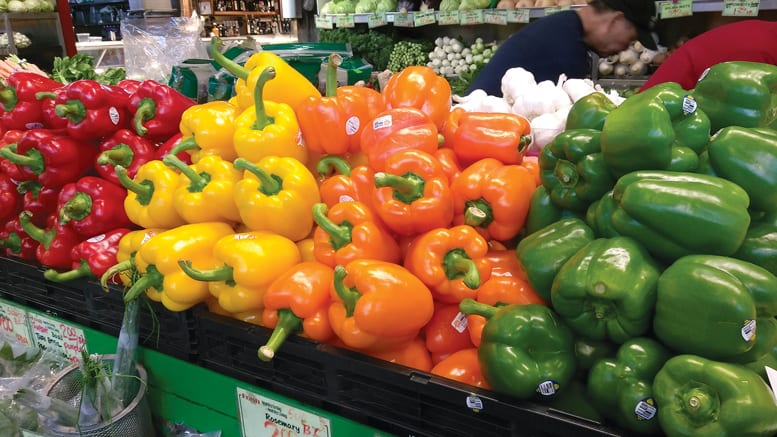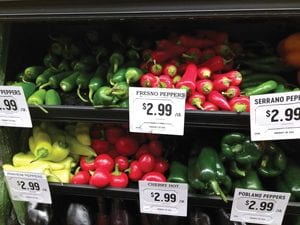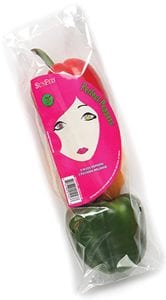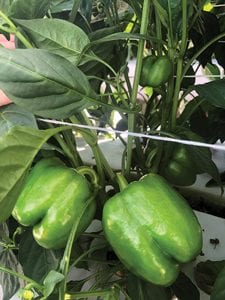Six Pillars Of Selling More Peppers
December 1, 2018 | 9 min to read
Retailers can enhance sweet pepper sales year-round by utilizing effective merchandising techniques, according to industry experts. Emphasizing the appeal of colored peppers, particularly the growing trend for mini varieties as healthy snacks, is crucial. Proper advertising strategies, coupled with seasonal promotions, further amplify consumer interest. Customizing display techniques and leveraging packaging can improve convenience and accessibility for shoppers. Ultimately, education about the versatility of peppers can drive continual sales increases.

Originally printed in the December 2018 issue of Produce Business.
Focusing on a few areas of best practice helps retailers increase sweet pepper sales year-round.
 Colored sweet peppers are a reliable staple in produce, and retail can continue to add profit year-round with a few key merchandising techniques. “Pepper sales are consistent all year,” says Jimmy Coppola, account manager at Westmoreland-TopLine Farms in Leamington, Ontario, Canada. “Though weather can create shortages or oversupply can be a factor at other times, as long as stores keep the demand up with proper ad placements and proper pricing strategies, the supply during peak production periods moves through seamlessly.”
Colored sweet peppers are a reliable staple in produce, and retail can continue to add profit year-round with a few key merchandising techniques. “Pepper sales are consistent all year,” says Jimmy Coppola, account manager at Westmoreland-TopLine Farms in Leamington, Ontario, Canada. “Though weather can create shortages or oversupply can be a factor at other times, as long as stores keep the demand up with proper ad placements and proper pricing strategies, the supply during peak production periods moves through seamlessly.”
Peppers are a good sell all year long agrees Mark Cotê, produce merchandiser for Redner’s Markets in Reading, PA, with 43 Stores. “There’s really no season for peppers,” he says. “But we do see some seasonal differences. When there is an abundant harvest, it can lower the price because supply/demand comes into effect. Weather factors can also make a difference in marketing. And in summertime, we may sell more because of use in salads or grilling.”
New products in the category stimulate consumer interest. “The pepper category continues to be driven by specialty and hothouse varieties, such as the sweet mini peppers and sweet-colored bells,” says Chris Ciruli, chief operating officer for Ciruli Brothers in Rio Rico, AZ. “Production-wise, there is a growing trend for peppers produced in protected structures.”
Keith Cox, produce category manager at K-VA-T Food Stores in Abingdon, VA, with 130 stores, reports profitable changes in the sweet pepper category include new packaging, availability and retails on colored peppers being similar to a green pepper. “And, mini sweets have become a hot trend in the pepper category,” he says.
Over the past 10 years, specialty peppers have grown in use and acceptance, agrees Randy Bailey, president and owner of Bailey Farms in Oxford, NC, growers of Bellafina Baby Bell and Minisweet Peppers. “Consumers have become more adventurous in their eating habits and incorporating more diverse flavors into their dishes,” he says. “Planned promotions timed with key holidays or other key time periods will definitely help increase sales. Tailoring the pepper assortment to the store demographic and properly merchandising also helps sales.”
1: Put Color to Work
One of the best tools retailers have at their disposal for merchandising sweet peppers is their color. “Green is still the main color sold,” says Jerry Havel, director of sales and marketing for Fresh Farms in Nogales, AZ. “But red, yellow and orange colors are growing in popularity, too. Normally for the colored-pepper ratio, we ask growers for 65 to 70 percent red, then 15 percent of orange and yellow.”
Havel estimates approximately 70 percent of bell peppers marketed are green and about 30 percent red, with a smaller percentage of yellow and orange filling out the mix.
At Redner’s, the traditional green pepper has taken a back seat to the colored peppers, says Cotê. “Whether the Rouge from Mexico or the hothouse Holland peppers, colored peppers have really gained in popularity and are getting a lot more advertising.”
Ciruli says mixing colors in a display makes it more attractive to consumers. “Colored peppers have a different, slightly sweeter flavor and give the customer more options,” he says.
Though there’s a lot of talk about “eating green,” Pedro Batiz, vice president of sales, Divine Flavor, San Diego, CA, points out since research shows the need to incorporate multiple colors of vegetables into a diet to get all the right vitamins, stores can promote colored peppers for this. “That’s why our Tribelli mini peppers are so great,” he says. “They’re available in a trio of red, yellow and orange colors presented in a single package.”
2: Make Visible Displays
Display space and type for peppers vary by retail location and size of store, and marketers recommend each store customize. “We have some customers carrying up to three SKUs with multiple facings,” says Bailey. “We tend to work with each customer to benchmark their sales against the average and make a recommendation from there.”
Regardless of space, stores are advised to display peppers to pull customers to the category. “Space may vary depending on sales volume, but you should offer a full line of several options for the consumer,” says K-VA-T’s Cox. “A nice grouping of all sweet peppers displayed together will make a great sweet pepper destination area. While promoting on ad, a secondary display location is a must to drive sales and units.”
Shipper options, such as display boxes, are increasingly popular, explains Havel. “A lot of the higher-end stores are using a display-ready box that can be put right out on the floor,” he says. “It cuts down on labor for the stores. It also draws customer attention since it is a standalone display.”
Ciruli reports the value of getting peppers into secondary or cross-promotion. “We have seen inventive crossover displays either in the refrigerated or butcher isles of the store, where peppers are pre-cut into fajita mixes or skewered into pre-made shish kabobs,” he says. “These types of packs add value and are perfect for customers on-the-go looking to have dinner made quickly. Any time you can add value, you create an opportunity to drive sales.”
3: Offer Packaged As Well As Bulk
 Though bulk peppers, especially green ones, are still the major percentage of displays, marketers reference the importance of packaging. “Packaging is getting to be a big thing,” says Havel. “Everyone has a package, and lots of retailers sell peppers in the three-pack. Selling peppers in bags is also becoming more popular. Anytime you can sell more than one of something, it’s advantageous. Just check out what Aldi or Costco is doing.”
Though bulk peppers, especially green ones, are still the major percentage of displays, marketers reference the importance of packaging. “Packaging is getting to be a big thing,” says Havel. “Everyone has a package, and lots of retailers sell peppers in the three-pack. Selling peppers in bags is also becoming more popular. Anytime you can sell more than one of something, it’s advantageous. Just check out what Aldi or Costco is doing.”
Determining the ratio of bulk vs. packaged depends on the particular store. “Club stores tend to offer more multi-packs, whereas a regular supermarket store may sell more sweet peppers in bulk and possibly carry a multi-pack,” says Ciruli. “It really depends on the store format and the target demographic for their market.”
Redner’s witnesses growing advantages for packaged product. “Bulk yields a little more shrink, but packaged has a longer shelf-life,” says Cotê. “You can get better distribution with the packaged and you can mix them, for example the yellow-red-orange three-pack. Also, customers increasingly don’t want to think everyone was touching the product. We sell a lot of packaged product. The medium size in a four-pack bag is also showing success.”
At K-VA-T, Cox reports packaging of three and four packs of different colors are the most popular with consumers. “Since there are several sizes and packs on sweet peppers, it is easy to promote more often to keep the consumer engaged in the category on a regular basis,” he says.
Angela Gamiotea, marketing manager for J&J Family of Farms in Westlake, FL, says, “We are looking for efficient ways to package a three-count, stoplight pepper. We currently use a new flow pack operation, giving the organization the ability to create new value-added packages that drive lift in the pepper category. This new, state-of-the-art equipment gives us the option of building new packages with less plastic than traditional clams and is better for the environment.”
SunFed in Rio Rico, AZ, uses specifically designed MA/MH (modified atmosphere/modified humidity) bags to prolong the freshness of its peppers. “We are packing almost all of our commodities in a MA/MH bag,” says Matt Mandel, chief operating officer.
As consumers lean toward convenience, Westmoreland’s Coppola believes the industry will see more packages move through the tills. “There was once a time when 90 percent would go out in bulk, but today it is almost even bulk to packaged,” he says. “It all depends on customer preference. And as it looks currently, consumers demand convenience.”
4: Harness the Mighty Mini
 Stores can up the ante of their pepper category with ample displays of mini peppers. “Mini sweets have pushed the colored bell into the minds of the consumer as quick, healthy snacks and helped get kids interested in colored peppers,” says Gretchen Kreidler Austin, director of marketing at SunFed.
Stores can up the ante of their pepper category with ample displays of mini peppers. “Mini sweets have pushed the colored bell into the minds of the consumer as quick, healthy snacks and helped get kids interested in colored peppers,” says Gretchen Kreidler Austin, director of marketing at SunFed.
The mini pepper, emphasizes Batiz, has turned from a specialty item to a mainstream item because of the growing consumption. “This product delivers new and more practical snacking options,” he says.
As a plethora of mini items gain traction as snacks, Coppola recommends highlighting mini peppers. “Convenience and snacking options are growing,” he says.
Snacking options present ample retail opportunity to increase sales. “The mini pepper is a retail-ready product, and the strongest value on this product has been the snacking option,” says Batiz.
Cox reports K-VA-T strongly recommends promoting and merchandising mini peppers as a snack option to build sales. “Consumers see mini peppers as a snacking item, much like a mini peeled carrot,” he says. “Mini peppers work great in a vegetable tray, for example.”
Bagged mini sweets have been a hit for Redner’s from the start, according to Cotê. “We run ads on them once a month to promote them with great success,” he says. “We can see our customer base grabbing them throughout the month. It’s a good middle-of-the-road pepper for anything, but especially snacking.”
5: Use Ads To Up Sales
Retailers who plan pepper promotions and focus on ads will increase sales. Redner’s Cotê reports significant and lingering sales success with pepper ads. “Advertising helps everything,” he says. “At Redner’s, we frequently put peppers on ad. There is no better way to sell than to put it in the paper and online in our electronic advertising. We see a big lift in sales when peppers are on ad.”
Anytime a product is demonstrated or promoted, sales will go up, concurs SunFed’s Kreidler Austin. “Advertise on the front page with a great price or a new recipe,” she says. “Or, just do a super-simple demonstration, such as colored peppers cut into strips and used in place of chips for dips. We find the easiest use of produce tends to work the best for consumption.”
Redner’s runs ads on colored peppers at least twice per month, according to Cotê. “We are really successful when advertising colors,” he says. “Even after the ads are over and the product goes to full retail, customers are still buying them. Promotion really helps move colored peppers.”
Coordination with suppliers to take advantage of solid supply or seasonality is also important. “We like to offer promotions during periods of strong production and around events that are a good fit for certain peppers,” says Bailey of Bailey Farms.
Though pricing is very personal to each store, marketers recommend implementing strategies easy for shoppers. “Pricing strategies vary, but anytime you offer pricing per each or in multiples, you make it easier for consumers to understand the unit price, as opposed to promoting peppers by the pound,” says Ciruli.
Another favorable strategy recommended by Coppola is to lock in quarterly or monthly pricing. “Optimally, you want to adjust with trending market conditions and pricing,” he says. “Try to lock in a healthy amount, and for the rest, play with market conditions.”
6: Play On Trends
 Stores can capitalize on cooking and snacking trends to keep pepper excitement and sales going all year. Coppola advises syncing promotions with current trends. “If consumers are continually educated on the benefits of eating fruits/vegetables, and if the trend for healthier lifestyles continues, then vitamin-rich foods such as peppers sell themselves,” he says. “Demos and recipes don’t hurt either.”
Stores can capitalize on cooking and snacking trends to keep pepper excitement and sales going all year. Coppola advises syncing promotions with current trends. “If consumers are continually educated on the benefits of eating fruits/vegetables, and if the trend for healthier lifestyles continues, then vitamin-rich foods such as peppers sell themselves,” he says. “Demos and recipes don’t hurt either.”
To further capitalize on trends, Divine Flavor has partnered with international culinary magazine Honest Cooking and bloggers and influencers from their network. “We asked them to create their own recipes and variations on recipes in their own way,” says Batiz. “Retailers have access to this information and can recreate the recipes in-store for their customers. We also suggest setting up a ‘snacking section’ in produce and offering a live demo to encourage consumers to both taste and buy the peppers.”
Signage is another effective tool stores can use to draw attention and educate customers. “With consistent messaging via signage, regular promotions, and every day placement on the shelf, we anticipate more consumers will incorporate mini sweet peppers into their weekly shopping lists and learn to love their versatility and health benefits,” says Bailey.
J&J promotes the “local” aspect of its Florida peppers. “Consumers are very informed about where their produce is coming from,” says Gamiotea. “For us, highlighting the region our pepper comes from is important to our customers, as well as their shoppers. We suggest underlining that the pepper comes from a nearby area, which assures the consumer the pepper is fresh and didn’t require a long travel time.”
In the end, it really comes down to educating customers on the versatility of peppers, according to Batiz. “Stores can promote healthy snacks for back to school. Football game day can mean substituting peppers for potato skins. In the dead of winter, the message could be about getting enough vitamin C alongside maximum flavor. Peppers are a big hit with barbecuing season. Stir-fry is a good idea, but we also recommend recipes such as bruschetta, in addition to couscous.”
17 of 19 article in Produce Business December 2018

